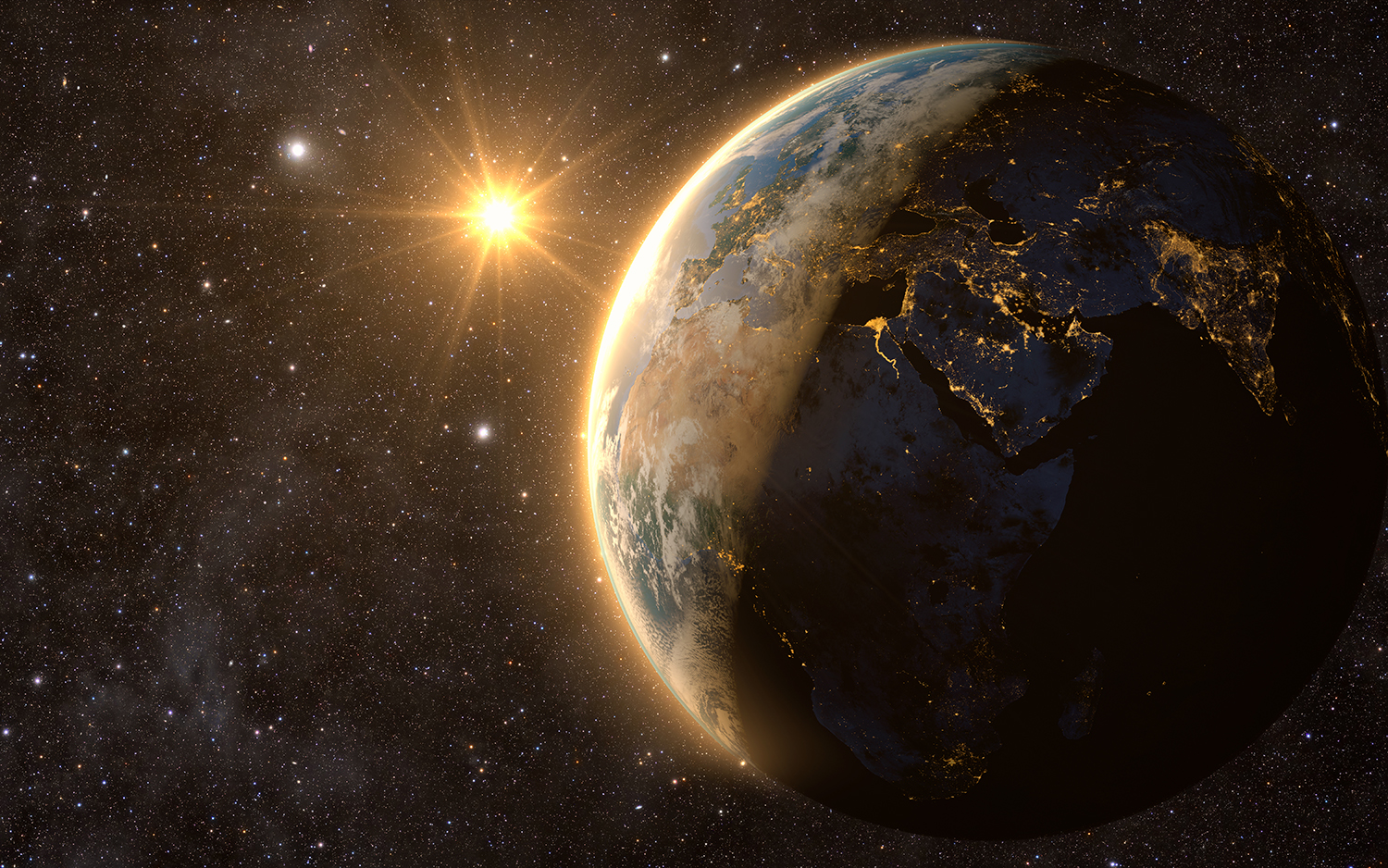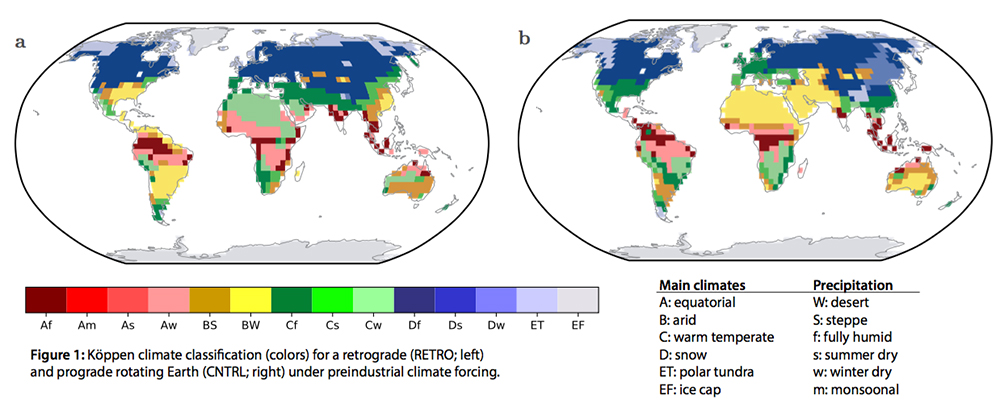What if Earth started spinning backward?

For billions of years, Earth has rotated in the same direction as the sun — but what if that direction were reversed?
Deserts would cover North America, arid sand dunes would replace expanses of the Amazon rainforest in South America, and lush, green landscapes would flourish from central Africa to the Middle East, according to a computer simulation presented earlier this month at the annual European Geosciences Union General Assembly 2018 in Austria.
In the simulation, not only did deserts vanish from some continents and appear in others, but freezing winters plagued western Europe. Cyanobacteria, a group of bacteria that produce oxygen through photosynthesis, bloomed where they never had before. And the Atlantic Meridional Overturning Circulation (AMOC), an important climate-regulating ocean current in the Atlantic, faded away and resurfaced in the northern Pacific Ocean, scientists reported at the conference.
Related: What if the world stopped turning?
During Earth's yearlong orbit around the sun, our planet completes a full rotation on its axis — which runs from the North Pole to South Pole — every 24 hours, spinning at a rate of about 1,040 mph (1,670 km/h) as measured at the equator. Its rotation direction is prograde, or west to east, which appears counterclockwise when viewed from above the North Pole, and it is common to all the planets in our solar system except Venus and Uranus, according to NASA.
As Earth rotates, the push and pull of its momentum shapes ocean currents, which, along with atmospheric wind flows, produces a range of climate patterns around the globe. These patterns carry abundant rainfall to humid jungles or divert moisture away from rain-parched badlands, for example.
Going retro
To study how Earth's climate system is affected by its rotation, scientists recently modeled a digital version of Earth spinning in the opposite direction — clockwise when viewed from above the North Pole, a direction known as retrograde, Florian Ziemen, co-creator of the simulation and a researcher with the Max Planck Institute for Meteorology in Germany, told Live Science in an email.
Sign up for the Live Science daily newsletter now
Get the world’s most fascinating discoveries delivered straight to your inbox.
"[Reversing Earth's rotation] preserves all major characteristics of the topography like sizes, shapes and positions of continents and oceans, while creating a completely different set of conditions for the interactions between the circulation and the topography," Ziemen said.
This new rotation set the stage for ocean currents and winds to interact with the continents in different ways, generating entirely new climate conditions around the world, the researchers reported in a project overview.
Spin cycle
To simulate what would happen if Earth were to spin backward (retrograde instead of prograde), they used the Max Planck Institute Earth System Model to flip the sun's rotational path — and thereby flip Earth's rotation — and reverse the Coriolis effect, an invisible force that pushes against objects traveling over a rotating planet's surface.
Once those alterations were in place and the model showed Earth spinning in the opposite direction, the researchers observed the changes that emerged in the climate system over several thousand years, as feedback among the rotation, atmosphere and ocean went to work on the planet, the scientists wrote in a description of the work, which they are currently preparing for publication.
Overall, the researchers found that a backward-spinning Earth was a greener Earth. Global desert coverage shrank from about 16 million square miles (42 million square kilometers) to around 12 million square miles (31 million square km). Grasses sprouted over half of the former desert areas, and woody plants emerged to cover the other half. And this world's vegetation stored more carbon than our forward-spinning Earth, the researchers discovered.
However, deserts emerged where they never had before — in the southeastern U.S., southern Brazil and Argentina, and northern China.
Turn, turn, turn
The change in rotation also reversed global wind patterns, bringing temperature changes to the subtropics and midlatitudes; continents' western zones cooled as eastern boundaries warmed, and winters became significantly colder in northwestern Europe. Ocean currents also changed direction, warming seas' eastern boundaries and cooling their western ones.
In the simulation, AMOC— the ocean current responsible for transporting heat around the globe — disappeared from the Atlantic Ocean, but a similar and slightly stronger current arose in the Pacific, carrying heat into eastern Russia. This was somewhat unusual, as a prior study that modeled a reverse-spinning Earth did not see this change, Ziemen told Live Science in an email.

"But as the AMOC is the result of many complex interactions in the climate system, there can be a lot of reasons for this difference," he said.
Related: Earth pictures: Iconic images of Earth from space
Altered sea currents in the Indian Ocean also allowed cyanobacteria to dominate the region, which they have never managed to accomplish while the Earth spins in its current direction, the researchers discovered.
But for Ziemen, the greening of the Sahara was the most intriguing change that appeared in their "backward" model of Earth.
"Seeing the green Sahara in our model got me thinking about the reasons why we have a desert in the Sahara, and why there is none in the retrograde world," Ziemen said. "It is this thinking about the most basic questions that fascinates me about the project."
Original article on Live Science.

Mindy Weisberger is an editor at Scholastic and a former Live Science channel editor and senior writer. She has reported on general science, covering climate change, paleontology, biology and space. Mindy studied film at Columbia University; prior to Live Science she produced, wrote and directed media for the American Museum of Natural History in New York City. Her videos about dinosaurs, astrophysics, biodiversity and evolution appear in museums and science centers worldwide, earning awards such as the CINE Golden Eagle and the Communicator Award of Excellence. Her writing has also appeared in Scientific American, The Washington Post and How It Works Magazine. Her book "Rise of the Zombie Bugs: The Surprising Science of Parasitic Mind Control" will be published in spring 2025 by Johns Hopkins University Press.









